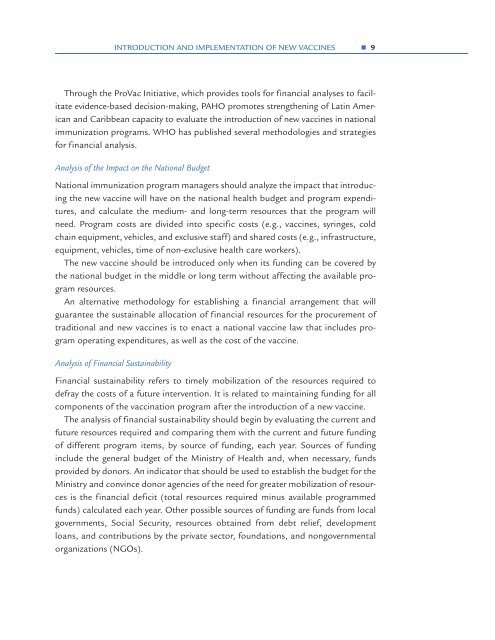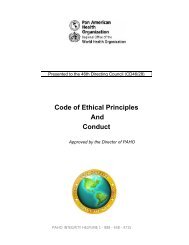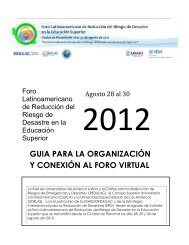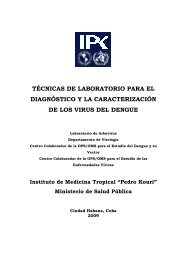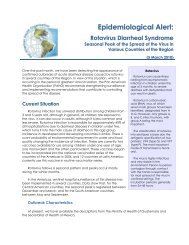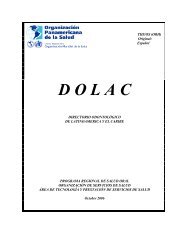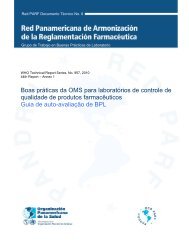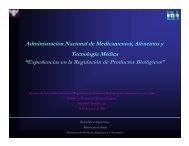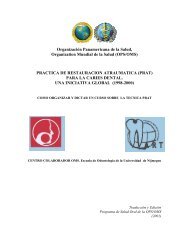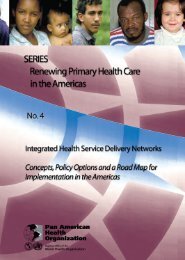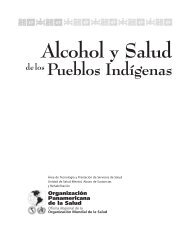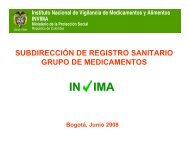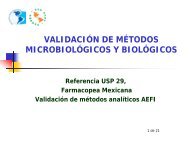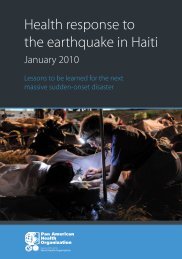Introduction and implementation of new vaccines: Field Guide
Introduction and implementation of new vaccines: Field Guide
Introduction and implementation of new vaccines: Field Guide
Create successful ePaper yourself
Turn your PDF publications into a flip-book with our unique Google optimized e-Paper software.
INTRODUCTION AND IMPLEMENTATION OF NEW VACCINES • 9<br />
Through the ProVac Initiative, which provides tools for financial analyses to facilitate<br />
evidence-based decision-making, PAHO promotes strengthening <strong>of</strong> Latin American<br />
<strong>and</strong> Caribbean capacity to evaluate the introduction <strong>of</strong> <strong>new</strong> <strong>vaccines</strong> in nation al<br />
immunization programs. WHO has published several methodologies <strong>and</strong> strategies<br />
for financial analysis.<br />
Analysis <strong>of</strong> the Impact on the National Budget<br />
National immunization program managers should analyze the impact that introducing<br />
the <strong>new</strong> vaccine will have on the national health budget <strong>and</strong> program expenditures,<br />
<strong>and</strong> calculate the medium- <strong>and</strong> long-term resources that the program will<br />
need. Program costs are divided into specific costs (e.g., <strong>vaccines</strong>, syringes, cold<br />
chain equipment, vehicles, <strong>and</strong> exclusive staff) <strong>and</strong> shared costs (e.g., infrastructure,<br />
equipment, vehicles, time <strong>of</strong> non-exclusive health care workers).<br />
The <strong>new</strong> vaccine should be introduced only when its funding can be covered by<br />
the national budget in the middle or long term without affecting the available program<br />
resources.<br />
An alternative methodology for establishing a financial arrangement that will<br />
guarantee the sustainable allocation <strong>of</strong> financial resources for the procurement <strong>of</strong><br />
traditional <strong>and</strong> <strong>new</strong> <strong>vaccines</strong> is to enact a national vaccine law that includes program<br />
operating expenditures, as well as the cost <strong>of</strong> the vaccine.<br />
Analysis <strong>of</strong> Financial Sustainability<br />
Financial sustainability refers to timely mobilization <strong>of</strong> the resources required to<br />
defray the costs <strong>of</strong> a future intervention. It is related to maintaining funding for all<br />
components <strong>of</strong> the vaccination program after the introduction <strong>of</strong> a <strong>new</strong> vaccine.<br />
The analysis <strong>of</strong> financial sustainability should begin by evaluating the current <strong>and</strong><br />
future resources required <strong>and</strong> comparing them with the current <strong>and</strong> future funding<br />
<strong>of</strong> different program items, by source <strong>of</strong> funding, each year. Sources <strong>of</strong> funding<br />
include the general budget <strong>of</strong> the Ministry <strong>of</strong> Health <strong>and</strong>, when necessary, funds<br />
provided by donors. An indicator that should be used to establish the budget for the<br />
Ministry <strong>and</strong> convince donor agencies <strong>of</strong> the need for greater mobilization <strong>of</strong> resources<br />
is the financial deficit (total resources required minus available programmed<br />
funds) calculated each year. Other possible sources <strong>of</strong> funding are funds from local<br />
governments, Social Security, resources obtained from debt relief, development<br />
loans, <strong>and</strong> contributions by the private sector, foundations, <strong>and</strong> nongovernmental<br />
organizations (NGOs).


